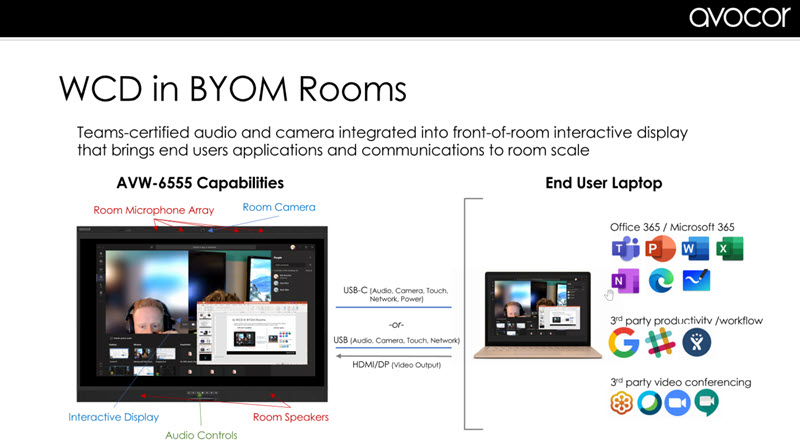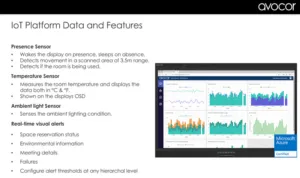We’ve written and posted a lot of stories relating to Covid-19, but many highlighting the difficulties in the supply chain. However, yesterday I heard how the pandemic has had a (relatively) positive aspect on one area of the display industry. Some 25 years ago, I gave a talk for (if I remember correctly) Iiyama about the future of the display industry. I said that ‘in ten years Intel will still be telling you that the next big thing is video conferencing. By ten years on, I was still saying the same. But not any more.

The reality is that Covid and Zoom have combined to make video calling ‘the new normal’ not only for businesses but for consumers. Whether it’s work, catching up with the family or attending a virtual Zumba or Pilates class, we’re all video conferencing now. That has changed things for businesses and has provided opportunities for suppliers that can make this technology work.
I’ve been covering this kind of meeting room technology for quite a long time. I remember some years ago meeting with InFocus about their Mondo pad. The system was very clever in marrying together voice, video and application sharing to enable virtual meetings. However, the firm told me at the time, the big barrier was the time it took to explain what they product did (and its competitors said that the issue was that much of its technology was a closed system, but that’s another story). I also remember a very impressive demonstration by Smart Technologies as it shifted focus more towards business applications from its base in education towards industrial and professional sharing systems.
However, I also remember a lot of discussions with companies (even major IT suppliers) that struggled to support such systems because, for example, the meeting room was the responsibility of an outside facilities management company, so the company’s own IT department was reluctant to allow any network access etc. In the real world of big companies, simple can easily become very complicated. So there is often an opportunity for those that can make the complicated relatively simple.
So, I was interested to catch up with Scott Hix (CEO) and Brian Carskadon of Avocor of the US to find out more about their latest Windows Collaboration Display (WCD) which has just been certified as the first, and currently only, WCD that is certified for use with Windows Teams. That’s important for the corporate market as big company IT departments as it helps calms any fears about security and other issues.
Avocor was set up four years ago by Hix, a veteran of the display industry at InFocus, Planar and elsewhere (I have been reporting on both him and Carskadon and Hix on this site and Display Monitor since 2002). It has focused on display systems and we have reported the company’s activities quite a few times. One I remember, was when I heard at BETT 2017 that the company had a Windows-based display that used the FlatFrog InGlass touch technology (A Breakthrough for Optical Touch?). We’d been reporting on that technology since 2010, and in 2014 I was impressed by the demo at ISE.
 Click for Higher Resolution Anyway, back to today. Hix explained that there have been just two authorised suppliers of Windows Collaboration Displays (a big topic at Infocomm 2018, when they attracted a lot of attention as Microsoft had created a lot of interest with its excellent, but delayed and expensive, Surface Hub product, but then stopped shipping it). Sharp was the other supplier (Sharp Premieres Windows Collaboration Display) and (Sharp Brings the World’s First Certified Windows Collaboration Display to Market), but Sharp has focused on the support of Skype for Business.
Click for Higher Resolution Anyway, back to today. Hix explained that there have been just two authorised suppliers of Windows Collaboration Displays (a big topic at Infocomm 2018, when they attracted a lot of attention as Microsoft had created a lot of interest with its excellent, but delayed and expensive, Surface Hub product, but then stopped shipping it). Sharp was the other supplier (Sharp Premieres Windows Collaboration Display) and (Sharp Brings the World’s First Certified Windows Collaboration Display to Market), but Sharp has focused on the support of Skype for Business.
Avocor, on the other hand, decided last year that getting Windows Team certification was important. That meant a lot of engineering, Carskadon said, and delayed the release of the latest version by around six months, but it has meant that it has won the ‘first and only’ spot. Given that Microsoft is moving away from Skype for Business towards Teams, that looks like a good move.
The new display is in 65″ and there may be other sizes, but these are likely to be smaller. At the beginning of the year, I would have bet that the next product would be bigger, but the reality of Covid is that there are fewer large meeting rooms and small ‘huddle rooms’ (or should that be ‘bubble rooms’) are what companies are looking for.
The product has been set up to be very simple to set up and operate and relies mainly on cable connections. One reason is that research shows that a meeting often takes 12-14 minutes to get started and that’s not very efficient. The ideal would be for everything to work seamlessly using USB Type-C, but that functionality is a bit mixed at the moment, so there is support for HDMI & DisplayPort, but the system is designed to ‘reset to standard’ whenever the display is disconnected. An unusual feature is a ‘Windows’ button that takes the display back to being a standards Windows system.
The display has quite a few sensors in it, for proximity, temperature and light. That means that remote monitoring can tell a facilities manager if a booked room is being used, for example, or if the room is getting too warm and needs the shades changing. This data is fed to the Azure cloud and Avocor has developed a dashboard subscription service to make the data useful under the Aquarius brand. More sensors can be added in the future, although Carskadon suggested these might be as add-ons rather than being integrated.
The hardware uses the latest InGlass technology which allows the use of passive pens and a resting palm on the display, while supporting palm rejection. It uses an optically bonded panel to minimise parallax. There are also stringent demands on the audio side which has been tuned to Microsoft’s Teams requirements and is optimised for small groups (for example with a wide angle camera that has compensation for potential distortion).
The product is shipping immediately and should prove an attractive option for corporates looking to get the most out of Microsoft Teams. (BR)

